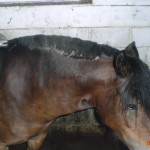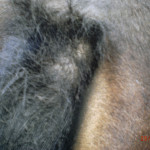Is your horse constantly itching? It could be Sweet Itch!
So, your horse/pony/donkey is itching non-stop and seems worse early evening and morning. The mane, neck and top of the tail seem to be the areas most effected, most probably because these are the places that horses find easiest to scratch. The area has been rubbed raw causing bald patches, looks very sore, might be ulcerated and in some places the skin has thickened. If all this sounds familiar, then it is likely your equine 4-legged friend is suffering from sweet itch.
Similar to an allergic reaction, horses affected by Sweet Itch often scratch, bite, and rub at irritated areas in an effort to relieve the intense itching. These behaviours can cause symptoms to persist for several weeks after the initial exposure to the insects.
What is in a name?
Despite its misleading name, there is nothing “sweet” about Sweet Itch. The term is believed to have originated years ago, when the condition appeared more frequently during periods of high grass sugar levels. It was once thought that “sweet” substances worsened the irritation, and the name has remained in use ever since.
What is Sweet Itch?
Sweet Itch is thought to affect at least 5% of the UK horse population, and doesn’t discriminate; it can be found in any breed of pony, horse or donkey. Some horses and ponies are more prone to Sweet Itch due to what is known as the ‘Pruritus Threshold’. This is the point at which they will start to itch themselves and become uncomfortable. Similar to our pain threshold, it differs between horses.
Sweet itch is a medical condition caused by a hypersensitivity reaction to specific allergens in the saliva of female Culicoides midges. The hypersensitivity response is mediated by an antibody produced by the horse’s immune system which binds the allergens, causing a cascade production of histamine and cytokiines which make the horse’s skin inflamed and itchy.
Sweet Itch is the name more commonly given to Pruritus or Summer Seasonal Recurrent Dermatitis (SSRD); it is also known as Summer Itch, Queensland Itch (Australia), Kasen (Japan), Sommer Ekzem (Germany) or the more technical term, Culicoides Hypersensitivity.
Signs to look out for:
- Excessive rubbing and scratching
- Loss of hair and broken skin in affected areas
- Vigorous swishing of the tail
- Agitated behaviour, head shaking, and lack of enthusiasm.
- Roll more than normal and scratch on anything available (even you!)
Remember:
I – inflamed sores
T – thickened
C – change in behaviour
H – hair loss
Often, the presence of one or more of these signs is typically used to diagnose sweet itch; however, there are many other allergies that show similar symptoms. It is best to consult your vet for an accurate diagnosis in identifying what triggers the reactions.
Prevention and Management
There is no known cure for Sweet Itch, therefore the best treatment is prevention. In the lead up to spring and throughout the warmer months, there is lots you can do to stay on top of the condition and help make your 4-legged friend more comfortable:
Location – Not always easy as we can’t just up sticks and move to the ideal location for sweet itch sufferers, so we have to do the best we can. Where possible, try to keep away from stagnant water/ponds, marshy ground and areas where midges like to gather.
Barrier techniques – fly sprays/insect repellents can have some effect, but a physical barrier is more effective. The use of rugs such as the Boett Blanket to prevent midges and insects landing on the skin; creams and ointments on the areas not covered by a rug; if access to stables, then stabling when the midges are at their worst (dawn and dusk). If indoors, then consider using fans as midges hate wind!
Shampoos – a non-allergenic or medicated shampoo won’t prevent the midges but can help soothe the skin and need to rub/itch, as well as preventing infection.
Please ensure that your equine has been professionally diagnosed with Sweet Itch before commencing with treatments, as sometimes Sweet Itch could be mistaken for other ailments.








